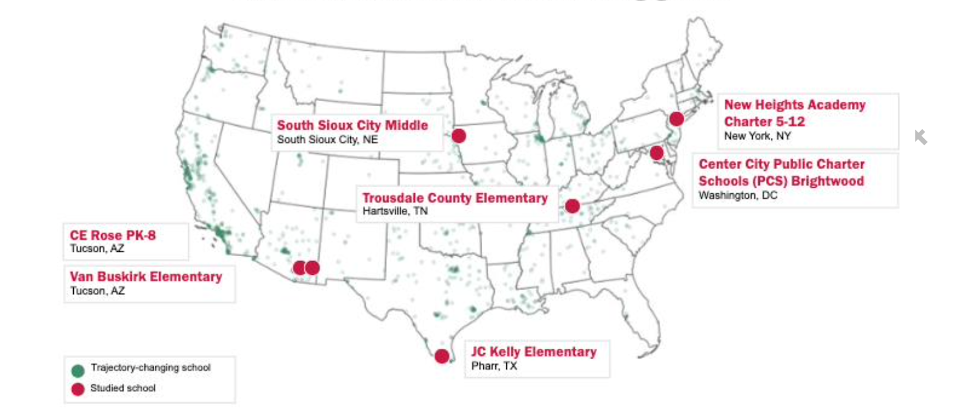“There are various colleges which might be efficient at serving to college students be taught, even in high-poverty communities,” mentioned Sean Reardon, a Stanford sociologist who was a part of the staff that developed the Stanford Training Knowledge Archive. “The TNTP report makes use of our knowledge to establish a few of them after which digs in to grasp what makes them significantly efficient. That is precisely what we hoped folks would do with the info.”
TNTP did establish seven of the 1,345 extremely efficient colleges that it chosen to check in depth. Solely one of many seven colleges had a majority Black inhabitants, reflecting the truth that Black college students are underrepresented at the best colleges.
The seven colleges ranged broadly. Some had been giant. Some had been small. Some had been metropolis colleges with many Hispanic college students. Others had been largely white, rural colleges. They used totally different tutorial supplies and did a whole lot of issues otherwise, however TNTP teased out three traits that it thought these colleges had in widespread.
Seven of the 1,345 colleges the place college students began behind however made giant studying positive aspects over a decade from 2009 to 2018

“What we discovered was not a silver-bullet answer, an ideal curriculum, or a rockstar principal,” the report mentioned. “As a substitute, these colleges shared a dedication to doing three core issues effectively: they create a tradition of belonging, ship constant grade-level instruction, and construct a coherent tutorial program.
Based on TNTP’s classroom observations, college students obtained good or robust instruction in 9 out of 10 school rooms. “Throughout all school rooms, the regular accumulation of fine classes—not unattainably excellent ones—units trajectory-changing colleges aside,” the report mentioned, contrasting this constant degree of “good” with its earlier statement that the majority U.S. colleges have some good instructing, however there may be a whole lot of variation from one classroom to the following.
Along with good instruction, TNTP mentioned that college students in these seven colleges had been receiving grade-level content material of their English and math courses though most college students had been behind. Academics in every college used the identical shared curriculum. Based on the TNTP report, solely a couple of third of elementary college academics nationwide say they “largely use” the curriculum adopted by their college. At Trousdale County Elementary in Tennessee, one of many exemplar colleges, 80 % of academics mentioned they did.
Whereas many schooling advocates are pushing for the adoption of higher curriculum as a lever to enhance colleges, “It’s attainable to get trajectory-changing outcomes with no excellent curriculum,” TNTP wrote in its report.
Academics additionally had common, scheduled classes to collaborate, focus on their instruction, and be aware what did and didn’t work. “Everybody holds the identical excessive expectations and works collectively to enhance,” the report mentioned.
The colleges additionally gave college students further instruction to fill data gaps and further follow to solidify their abilities. These further help courses, referred to as “intervention blocks,” at the moment are commonplace at many low-income colleges, however TNTP famous one main distinction on the seven colleges they studied. The intervention blocks had been related to what college students had been studying of their most important school rooms. That requires college leaders to ensure that interventionists, classroom aides and the primary classroom academics have time to speak and collaborate in the course of the college day.
These seven colleges all had robust principals. Though most of the principals got here and left in the course of the decade that TNTP studied, the faculties maintained robust outcomes.
The seven colleges additionally emphasised student-teacher relationships and constructed a caring neighborhood. At Brightwood, a small constitution college in Washington, D.C., that serves an immigrant inhabitants, workers members attempt to be taught the names of each scholar and to be collectively chargeable for each their teachers and well-being. Throughout one workers assembly, academics wrote greater than 250 scholar names on large pads of paper. Academics put verify marks by every little one they felt like that they had a real relationship with after which brainstormed methods to achieve the scholars with out checks.
At New Heights Academy Constitution College in New York Metropolis, every instructor contacts 10 dad and mom per week—by textual content, electronic mail, or telephone—and logs the calls in a journal. Academics don’t simply name when one thing goes incorrect. Additionally they attain out to folks to speak about an “A” on a check, educational enchancment, or good attendance, the report mentioned.
It’s at all times dangerous to focus on what profitable colleges are doing as a result of different educators is likely to be tempted to simply copy concepts. However TNTP warns that each college is totally different. What works in a single place won’t in one other. The group’s recommendation for colleges is to vary one follow at a time, maybe beginning with a class that the varsity is already fairly good at, and enhance it. TNTP warns in opposition to making an attempt to vary too many issues without delay.
TNTP’s view is that any college can grow to be a extremely efficient college, and that there aren’t explicit instructional philosophies or supplies {that a} college should use to perform this uncommon feat. Numerous it’s merely about rising communication amongst academics, between academics and college students, and with households. It’s a bit like weight-loss diets that don’t dictate which meals you’ll be able to and can’t eat, so long as you eat much less and train extra. It’s the fundamental rules that matter most.
Contact workers author Jill Barshay at (212) 678-3595 or barshay@hechingerreport.org.
[ad_2]
